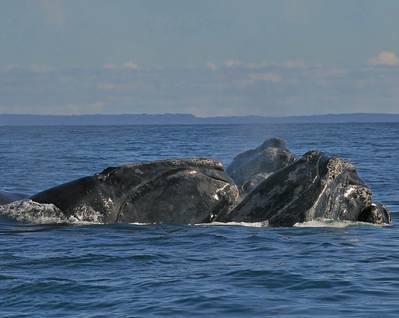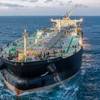Threat to Whales Complicates US Research into Seaweed for Biofuel
In Cape Cod Bay, 10-year-old Pilgrim and her calf skim the water's glassy surface alongside the Shearwater research vessel to feed on tiny crustaceans.
The two are among the last surviving 340 or so North Atlantic right whales left migrating along the U.S. East Coast – down from 480 right whales in 2010.
The biggest threats they face include being struck by passing ships or getting entangled in ropes used for lobster fishing off the U.S. East Coast - scientists have recorded 98 such injuries or deaths of whales since 2017.
Now, the whales face another threat as the U.S. Department of Energy tries to boost clean energy production by ramping up research into seaweed, or kelp, as a potential source of biofuel, scientists say.
The DOE has funneled tens of millions of dollars into such research. If proven viable, seaweed offers a more eco-friendly alternative to corn-based ethanol, proponents say.
But whale biologists are worried. As with traditional lobster fishing, seaweed farms involve fields of ropes strung up underwater for the kelp to grow on.
While there hasn't yet been a documented case of a whale getting tangled in seaweed ropes, Woods Hole Oceanographic Institution marine biologist Michael Moore is worried: "Wherever there's rope in the water column, there is entanglement risk," he says.
Fueling up
For the United States, seaweed aquaculture is still a nascent business, but growing fast. U.S. farmers produced 440 metric tons in 2021 – up from 18 metric tons in 2017.
Most of what's been harvested has gone into food, pharmaceuticals or cosmetics. But with research sites along the Eastern Seaboard, U.S. officials hope energy leaders might bring seaweed into their biofuel plans if it can be proven as a cost-effective alternative to corn.
"Renewable liquid fuels are especially attractive, because they allow us to leverage existing liquid fuel infrastructure," said oceanographer Simon Freeman, who heads the DOE's Advanced Research Projects Agency-Energy program funding seaweed research.
Kelp supporters also note that corn, unlike seaweed, takes up increasingly scarce land and freshwater, while also needing agrochemicals that then pollute waterways.
The DOE has spent more than $55 million since 2017 on 21 projects exploring whether seaweed production can be scaled to meet some of U.S. energy demand.
The department says the country has enough coastline with the right conditions to grow at least 500 million metric tons of seaweed per year - which could make up to 2.7 quadrillion BTUs of biofuel, roughly 10% of U.S. annual energy demand in transportation.
For now, kelp can't beat corn's low cost. U.S. seaweed production costs, running at $300 to $1,000 per metric ton, need to drop to around $80 to compete with corn, Freeman said.
Big oil companies including Exxon had for years studied the possibilities of making biofuel from microalgae, a plant-like organism that's invisible to the naked eye, but eventually backed out over concerns about cost and scalability.
"Algae still has real promise as a renewable source of fuel, but it has not yet reached a level that we believe is necessary to achieve the commercial and global scale needed to economically replace existing energy sources," Exxon spokesperson Chevalier Gray said.
But while microscopic algae is hard to separate from water, larger algae such as sugar kelp is easier to harvest by hand - growing as long as 5 meters (16 feet).
In the water
Kelp grown around New England is often harvested in spring - around the same time North Atlantic right whales feed in the area, slowly following their cold-water prey up to Canada.
The state of Massachusetts has granted coastal permits to five farms for sugar kelp, a strain of large brown seaweed. But they won't allow any new kelp sites with fixed ropes in deeper waters known to be important areas for right whales, said Christian Pepitas of the state's marine fisheries division.
For New England waters more than 5.6 kilometers (3 nautical miles) offshore, the U.S. Army Corps has granted permits for 235 seaweed projects since 2018.
Citing concerns over entanglement, the federal government now regulates rope use in the lobster fishery and has implemented seasonal closures. The waters of Cape Cod Bay, for example, are off limits to lobster fishers until all right whales have left.
For states with a large dependence on the lobster fishery, the seaweed development agenda smacks of hypocrisy.
"Maine would have concerns about large aquaculture project siting, particularly with intensive reliance on ropes to grow kelp, at a time when Maine fishermen are being asked to remove rope from the ocean to protect right whales," said spokesperson Jeff Nichols of Maine's marine resources department, which has so far permitted coastal seaweed farms covering nearly 50 hectares (120 acres).
'A balancing act'
After a long day of harvesting kelp, John Lovett, owner and operator of Duxbury Sugar Kelp, relaxes on his boat in the shallow waters of Cape Cod Bay, near where he has a narrow 4-hectare (10-acre) farm.
When Lovett applied for a permit a few years ago, state regulators made him move his proposed location to a more sheltered area of the bay over cetacean concerns.
Now he's testing out whale-friendly kelp gear in collaboration with Woods Hole. An acre of his shallow water plot is dedicated to research.
Whereas traditional kelp lines are often placed just 2 meters (7 feet) below the surface, "we pin the kelp arrays very close to the ocean floor," he said. "Whales theoretically can go over top of it."
He's also experimenting with stiff fiberglass rods to replace rope, designed to break rather than ensnare a whale bumping against them. Lovett hopes their designs, once proven, could be taken to future offshore sites in deeper waters where whales travel.
Woods Hole researcher Scott Lindell, the recipient of a $4.9 million DOE grant for sugar kelp biofuel research, has discussed with biologist Moore on planning for expanding kelp production as whales follow prey into new areas amid ocean warming.
"If whale migrations become so unpredictable and regulations tighten up, we may have to go to stiffer structures, which will increase the price and make it more expensive to operate" kelp farms, Lindell said.
Ultimately, he said, "it's a balancing act between 'How do we produce low-carbon fuels with minimal risk to protected species?' and 'How we can produce a low carbon future?'"
(Reuters - Reporting by Gloria Dickie; Additional reporting by Lauren Owens Lambert, editing by Deepa Babington and Katy Daigle)













